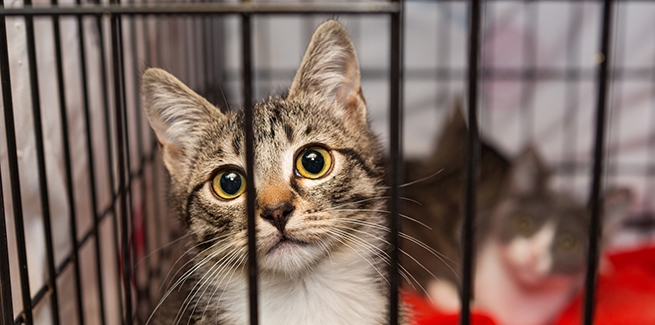New cageless cat lab could revolutionize feline research

As studies, go, the results were mixed.
The researchers had two objectives. The first: determine if a contraceptive vaccine would be effective in preventing feral cats from breeding in the wild. The second, and possibly more ambitious: establish a humane paradigm shift in feline research.
They published their results in two different scientific papers that detail how they failed to achieve their first objective, but may have achieved their second. If so, it could influence the way future cat studies are conducted, not to mention saving the lives of the cats used in those studies.
To bridge the gap between field studies of feral cat populations and traditional laboratory-based research, University of Illinois scientists pioneered a hybrid research facility to test the effectiveness of an injectable contraceptive vaccine (GonaCon) on feral cats. GonaCon has been shown to be effective in several mammal species, including swine, deer, and horses.
And, in a 2011 study, it showed promise as a contraceptive vaccine for cats, too. That study used purpose-bred cats in a traditional laboratory environment, with the cats kept in cages on shelves.
One of the limitations of using purpose-bred animals from private dealers for scientific research is that purpose-bred animals often suffer from inbreeding, which means that genetic factors can throw off test results. So the Illinois researchers wondered if GonaCon would have the same promising effect on a feral population of genetically diverse cats. In other words, outbred cats as opposed to inbred cats.
To find out, they would have to create a new research approach that simulated the living conditions of free-roaming feral cats—one that met high standards for both animal welfare and scientific rigor.
That meant getting away from racks of cages in gleaming laboratories.
Instead, they built a two-story pole barn with a wrap-around loft to house the 35 cats recruited for the study.
Inside, the cats had plenty of places to play, socialize, or spend time alone. Outside, they had access to a large, enclosed yard with high, predator-proof fencing, and enrichment to promote physical and psychological wellbeing.
Lead researcher Amy Fischer, PhD, a teaching associate in the Department of Animal Sciences at the University of Illinois, told NEWStat, “The hybrid is a good intermediate step between the laboratory and a field trial, because it allows for confinement and monitoring of the population along with an opportunity to provide the cats with a comfortable, enriched environment.”
Unlike the purpose-bred cats in the 2011 study, these cats came from animal shelters and private homes. All were healthy but at high risk of euthanasia for various reasons. The cats spent up to 18 months in the experimental facility, were administered either GonaCon or a placebo, then entered into a breeding trial.
At the end of the study, the cats were adopted out to new homes, unlike many cats used in research, who, historically, are often euthanized.
As to the researchers’ first objective: The results of the breeding trial led them to conclude that GonaCon would likely be ineffective at controlling feral cat populations. Fischer said the decreased effectiveness of the vaccine compared to the 2011 study could be due to a number of factors, “including the genetic diversity of our study population or variability in the vaccine.”
She said they don’t know if the facility itself influenced the results.
Fischer is more upbeat about their second objective: to establish a paradigm shift in feline research. She says their hybrid design would work for any feline study “in which the quality of the data collected would not be adversely impacted by a genetically diverse population and a more relaxed environment than what would typically be employed in a traditional laboratory setting.”
In fact, Fischer says that other researchers and even shelters have already inquired about the hybrid design.
And if other people are catching on, it means the paradigm is starting to shift.
Photo credit: © iStock/Okssi68



